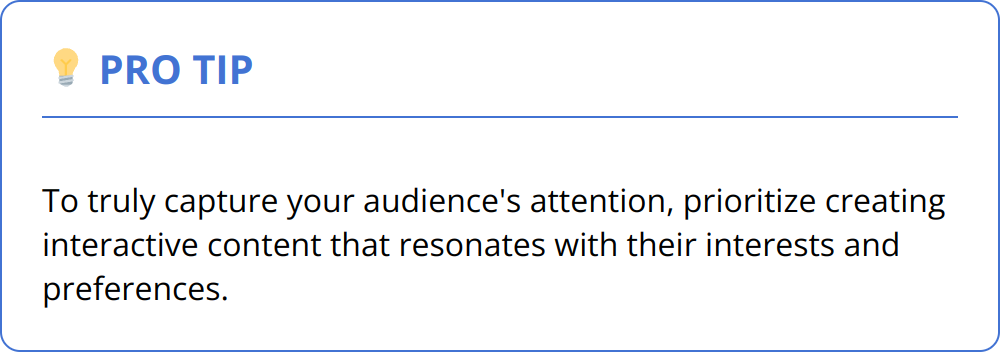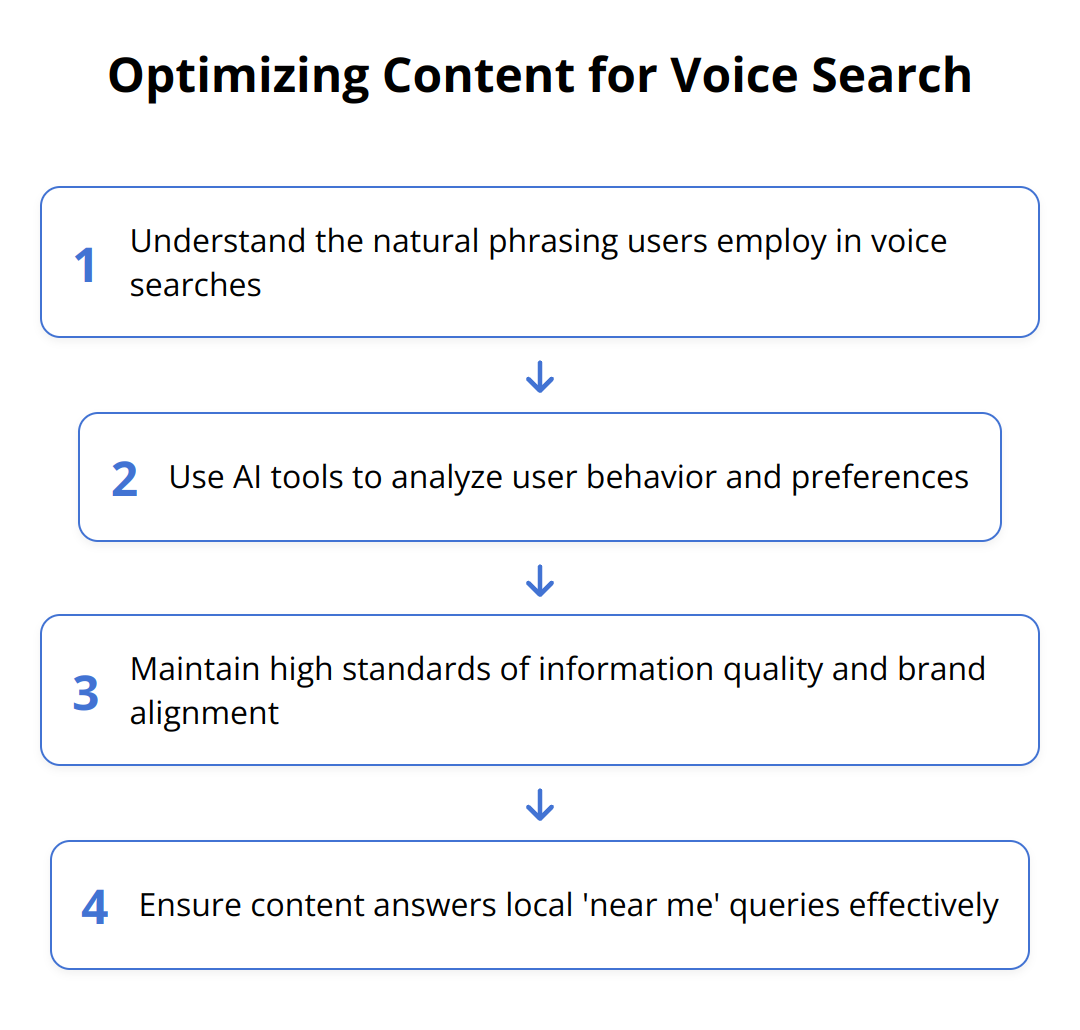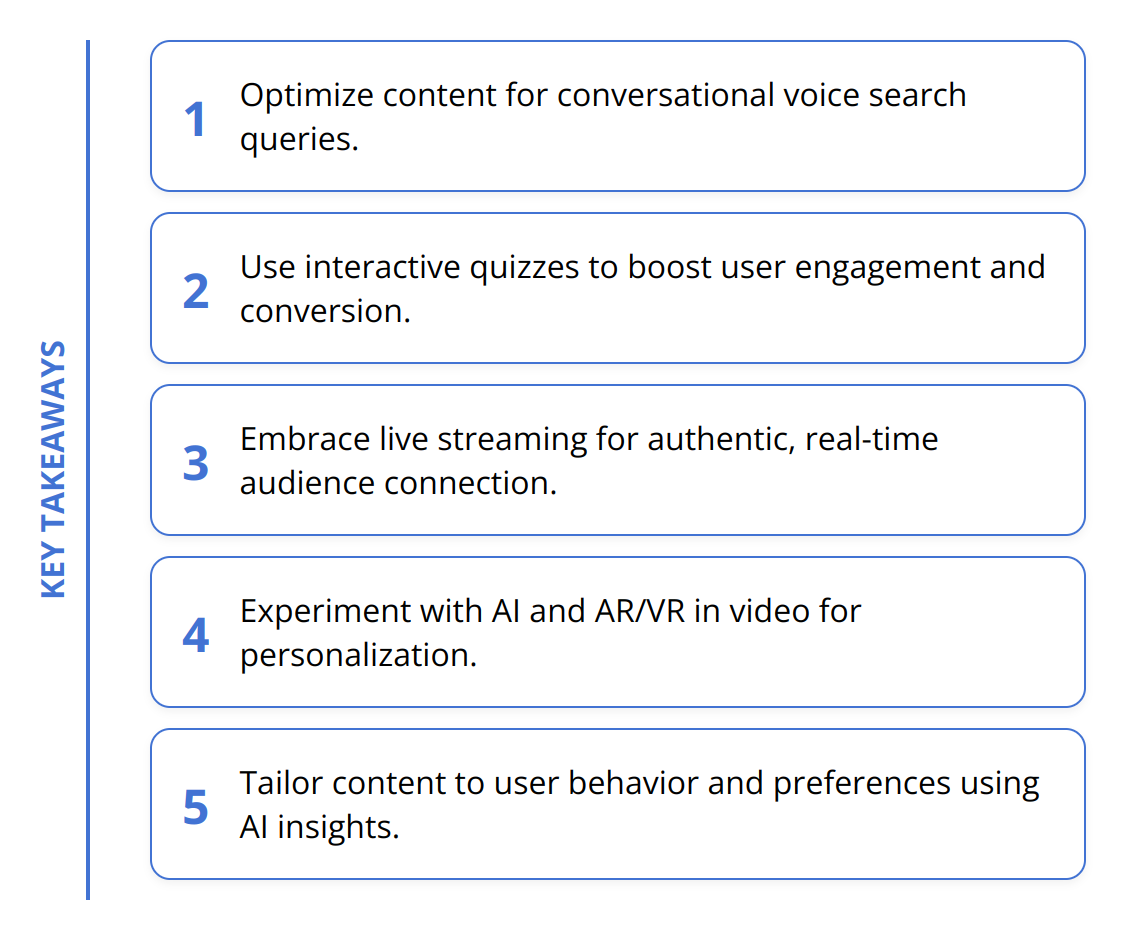We at Emplibot are constantly exploring how Artificial Intelligence shapes the future of content creation and consumption. This exploration highlights significant trends that are defining the digital landscape. From interactive content that captivates users to the evolution of video and live streaming, AI’s influence is unmistakable. As technology advances, understanding these trends becomes not just beneficial but necessary for innovators and creators alike.
Engaging With Interactive Content
The drive to capture and retain user attention in an ever-competitive digital landscape has led us to a significant pivot towards interactive content. This swift transition isn’t merely a trend; it’s a reflection of what audiences now demand: engagement, personalization, and active participation in their content consumption experience.
The Critical Role of Engagement
Engagement has become the linchpin in the relationship between content creators and their audience. It’s no longer about passively consuming information. Today’s users want to be a part of the narrative, to feel like they’re directly interacting with the content they consume. In practical terms, this means crafting experiences that require active user input—whether that’s answering a poll, navigating a storytelling journey, or customizing content in real-time. Engagement metrics skyrocket with interactive content, as it transforms passive viewers into active participants. For instance, interactive quizzes have been known to generate conversion rates upwards of 50%, a testament to their efficacy in capturing user interest.
Exploring Forms of Interactive Content
Interactive content comes in various shapes and sizes, each serving different strategic functions. From quizzes and polls to interactive infographics and videos, the key is to match the content type with your audience’s preferences and your marketing goals. Augmented reality (AR) and virtual reality (VR) experiences, for example, can offer immersive explorations of products or services, significantly enhancing user experience and brand perception. Meanwhile, interactive eBooks and whitepapers can transform static reading into a dynamic learning experience, boosting content value and user retention. A standout example of interactive content in action is BuzzFeed’s quizzes, known for their virality and high engagement rates.
Enhancing User Experience
The impact of interactive content on user experience (UX) cannot be overstated. It makes the content consumption journey memorable, personalized, and significantly more enjoyable. Interactive content often leads to higher dwell times and lower bounce rates, signaling quality engagement to search engines and improving SEO rankings. Moreover, it provides invaluable data insights into audience preferences and behaviors, enabling more targeted content strategies. The lesson here is clear: by prioritizing user engagement through interactive content, brands can forge stronger connections with their audience, driving loyalty and conversion in the process.

To effectively implement interactive content, consider these actionable tips:
-
Identify your goals: Determine what you aim to achieve with interactive content—be it lead generation, education, or brand awareness.
-
Know your audience: Understand their preferences, challenges, and tendencies to tailor interactive experiences that resonate.
-
Start small: Experiment with simple forms of interactive content like polls or quizzes before advancing to more complex formats.
Interactive content is not just a trend—it’s the future of digital engagement. By embracing these strategies, content creators can dramatically boost user interaction, providing value that keeps audiences coming back for more. For a deeper dive into crafting engaging content with AI assistance, visit our guide on enhancing your content.
Video and Live Streaming: What’s Next?
Following the major shift toward interactive content, we’re witnessing a parallel surge in video consumption and live streaming. This is not just a fleeting trend; it’s a powerful movement that’s reshaping the way brands connect with audiences. Video content, with its inherent ability to convey messages in a visually engaging manner, is becoming indispensable. Live streaming adds another layer, offering real-time engagement that can significantly amplify brand presence.
The Unstoppable Rise of Video Content
Statistics reveal a staggering increase in video consumption across all demographics. It’s predicted that an average person will spend 100 minutes per day watching online videos in 2021, a 19% increase from 2019. These numbers underscore the growing influence of video content in daily lives. Moreover, videos are not just being watched more; they are also driving purchase decisions, with 84% of consumers claiming that watching a brand’s video has convinced them to buy a product or service.
The power of video lies in its ability to engage emotionally. Humans are visual creatures, and videos have the unique capacity to elicit emotions, whether it’s excitement, laughter, or empathy. This emotional connection makes video content a critical tool in storytelling, helping brands to forge a deeper relationship with their audience.
Livestreaming as a Dominant Marketing Strategy
Live streaming has emerged as a formidable marketing tool, offering authenticity and immediacy that pre-recorded videos cannot match. It allows for real-time interaction, making viewers feel more connected and involved with the brand. This level of engagement is invaluable, as it builds community, loyalty, and trust.
Applications of live streaming range from product launches and Q&A sessions to behind-the-scenes tours and events coverage. The key to effective livestreaming is authenticity; viewers seek genuine interactions, not scripted sales pitches.

Preparing for the Future of Video Content
As we look ahead, the future of video content is bound to evolve with technological advancements, particularly in areas like AI and AR/VR. These technologies can potentially transform video content, making it even more interactive, personalized, and immersive. For instance, AI can be used to analyze viewer preferences and deliver tailored video recommendations, enhancing user engagement.
Actionable tips for leveraging video and live streaming:
-
Understand your audience: Tailor your video content and live streaming efforts to match their preferences.
-
Focus on storytelling: Use videos to tell stories that resonate emotionally with your audience.
-
Embrace authenticity in live streaming: Let your brand’s personality shine through in real-time interactions.
-
Experiment with technology: Explore AI, AR, and VR to make your video content more engaging and personalized.
The rise of video and live streaming is undeniable. By embracing these mediums, brands can deepen their connection with audiences, delivering content that’s not just seen but felt. For further insights, check out our post on leveraging AI for video marketing.
Voice Search Meets AI Content
With the advent of smart speakers and voice-activated devices, voice search has become an essential part of our digital interaction, fundamentally altering how we seek information online. Artificial Intelligence plays a pivotal role in tailoring content for voice search, striving to offer the most relevant, personalized answers to users’ queries. However, crafting AI-generated content that fits seamlessly into this evolving landscape presents its set of challenges.
The Surge in Voice Search Popularity
Voice search usage is on an impressive rise, changing the way keywords are used and how content is discovered. Users tend to use longer, more conversational phrases when performing voice searches compared to the more keyword-centric queries in traditional search engines. This shift demands a more natural, engaging content approach that AI can help achieve. By 2022, it was estimated that 55% of households would own a smart speaker, underscoring the growing significance of optimizing content for voice search.

AI’s Contribution to Personalization
AI excels in analyzing vast amounts of data, including search queries, user preferences, and behavior patterns. This capability is invaluable for creating personalized content. Personalization isn’t just about addressing the user by name; it’s about delivering content that matches their current interests, questions, or location. AI’s predictive analytics can forecast what information a user might seek next, making content recommendations more accurate and relevant.
Challenges Surrounding AI-Generated Content
While AI-generated content can save time and resources, it also faces skepticism regarding its authenticity and ability to match the human touch. Users crave content that resonates on a personal level, something purely AI-generated pieces might lack. Moreover, maintaining a consistent brand voice and ensuring content accuracy are perennial challenges. To combat these, a hybrid approach combining AI’s efficiency with human oversight proves to be most effective.

Practical Approaches to Embracing Voice Search and AI Content
-
Optimize for conversational language: Understand the natural phrasing users employ in voice searches and integrate these into your content.
-
Leverage AI for insights: Use AI tools to gather data on user behavior and preferences, tailoring your content strategy accordingly.
-
Prioritize accuracy and quality: Even with AI’s assistance, thoroughly review content to maintain high standards of information quality and brand alignment.
-
Focus on local SEO: Many voice searches are local. Ensure your content answers the “near me” queries effectively.
As the digital sphere evolves with voice search and AI-generated content, the challenge lies not in adopting these technologies but in leveraging them smartly to enhance user experiences. Those who understand and embrace the nuanced requirements of voice search optimization and AI-generated content’s potential while managing its limitations will stand out. For more insights on optimizing content for voice search, see our guide on voice search strategies.
Wrapping Up
The influence of Artificial Intelligence on content trends is both profound and transformative. We’ve discussed the unprecedented shift towards interactive content, the unstoppable ascent of video and live streaming, and the pivotal role of voice search, all underpinned by AI’s advanced capabilities. These trends underscore not just the change in how content is created and consumed but also highlight the opportunities for brands and content creators to connect with their audience on a deeper level.

Staying abreast of these trends is essential. The digital landscape is in a constant state of flux, with AI driving innovation at an incredible pace. Being informed enables creators and marketers to make strategic decisions that align with evolving consumer expectations and technological advancements.
We at Emplibot strongly encourage content creators to explore these AI-driven trends. Whether it’s leveraging interactive content to boost engagement, harnessing the power of video to forge emotional connections, or optimizing for voice search to improve user experiences, there is an immense scope of opportunity to innovate and stand out.
Moreover, embracing tools like Emplibot can significantly streamline content creation processes. By publishing SEO-friendly articles 100% automatically to your WordPress site, including keyword research, images, and internal linking, Emplibot aids businesses in keeping their blog active and engaging without constant manual intervention.
In conclusion, the intersection of AI and content creation represents a frontier of vast potential. The key to unlocking this potential lies in staying informed, adopting the right tools, and committing to innovation. As we move forward, the ability to adapt and embrace these changes will distinguish the leaders in content creation and digital marketing. The future of content is here, and AI is at its helm.

